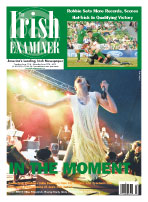


SERVICES
Tuesday November 20, 2012
There's More To Irish Dance Than Tippety-Tippety Tap!
Timothy Kochka Making the Dingle Diwali leap (Matthew Murphy) By Gwen Orel A few years ago I covered the opening of the Lord of the Dance movie for Speakeasy, the culture blog of the Wall Street Journal, and Neil Genzlinger, who writes for the New York Times, asked me if that was what Irish dance was all about. Yes. And no. The tap sounds are part of a genre called "percussive dance," which includes clogging, tap, and more. Since Riverdance exploded on the scene in as part of the 1994 Eurovision Song Contest, then called "Time Dance," Irish step dance has been pretty much equivalent with "Irish dance." But as companies like Fabulous Dance Theatre, who performed so thrillingly in Rian last week as part of the White Light Festival at Lincoln Center (see the review on the New York Irish Arts blog at newyorkirisharts.blogspot.com/2012/11/dancers-of-fabulous-beast-dance-theatre.html), and New York's Darrah Carr Dance make clear, there is more to Irish dance than that. In fact, even in Riverdance, Irish step was embracing new forms: Bill Whelan's original music presented Eastern European rhythms. Jean Butler and Michael Flatley used their arms non-traditionally and broke out of rigid stances. Jean's costume, a short black dress, was groundbreaking. This past weekend at Irish Arts Center, Darrah Carr's ModERIN company premiered new work by guest choreographer Seán Curran, as well as performed the piece that won them a 2012 Bessie Award Nomination, and some repertory work from Darrah. The evening also included traditional music from fiddler Liz Hanley, accordionist Niall O'Leary and flutist Christel Rice. The performances were emotionally evocative, fresh, and exciting. There is clearly a hunger for this kind of fusion: on Saturday night, the Irish Arts Center was so full that the show began late as more chairs had to be brought in. "Dingle Diwali," choreographed by Curran, received the New York Dance and Performance Award, aka as a "Bessie," for "Outstanding Production of a Work that Pushes the Boundaries of a Traditional or Culturally Specific Form." The work debuted at the Irish Arts Center last year. Curran's work, "Sé Caoineadh," or Six Laments, opens with poster-sized sepia and black-and-white photos of an earlier time. Immigrants, possibly, or those left behind. To music composed by Seamus Egan, dancers would get up and interact with a photo another was holding. In front of one that looked like a passport, perhaps, with the word "cancelled" stamped on it, a man in a vest and slacks dances and falls off pirouette, over and over. A pregnant Darrah Carr got up and, gesturing with longing to a photo of a plump baby, danced in silence. As Curran said later at a discussion, what Darrah did was a "monologue," she was a "kinetic actress." The lost baby and the lost dream could not have been more clear had Darrah sung the lament "ochone." There was in fact a sad ballad next-sung by fiddler Liz Hanley, who has a throaty, powerful delivery. She sang, accompanying herself first by plucking the fiddle and then playing in between verses. There was traditional Irish dance sprinkled throughout the evening too, and Ryan McCarthy's hard shoe, that came next, lifted our spirits as his legs moved in a whirl. "The Ballad of Eileen Pink and James Gray," with old-time-sounding music by Boston composer Mark Simos, is a particularly sweet number choreographed by Darrah, a kind of blend of square dance, Irish step, and modern, as we watch a couple court and spark, in between sequences of girls in pinafores dancing with them. Timothy Kochka and Caitlin McNeill had real chemistry in the Appalachian-inspired dance, which had a sweetness that was irresistible, particularly when the dancers did completely 21st Century things, like roll on the floor. "Dingle Diwali" had dancers, in print tunics, stepping to Indian mouth music. Occasionally as they passed by each other they'd move their arms so that they were the iconic image of an Indian god with many arms. The dance is surprising and exciting. Darrah's "ModERIN" gives us dancers making a Celtic knot of their arms and legs as they weave together Niall O'Leary, who has his own school of dance, played accordion in musical interludes, as well as spoons (which he makes look far too easy), and had a kind of hard-shoe "dance-off" with Darrah in "Rince na Spuineogai," which means, I think, "dance of the spoons." The final number, "Step Dance Suite," with music by Style and Liam Bradley, gave us something grand to the sound of pipes, as dancers marched and stepped to rousing sounds. In a post-show discussion, Curran described what he does as "speaking an old language in a new way, with a contemporary accent." He said, "It's all folk dance. We're the folks dancing, you're the folks watching." And as Darrah said, "So many Irish dancers were open to learning other forms of dance, after Riverdance," and of course, many dancers who would not otherwise have found it loved the form and began to learn Irish dance after seeing the show live or on television. It's a new world in Irish dance that continues to evolve. Darrah is teaching her fusion of Irish step and modern dance at Irish Arts Center in this winter session, see www.irishartscenteer.org for details. Gwen Orel runs the blog and podcast New York Irish Arts. |
CURRENT ISSUE

RECENT ISSUES


SYNDICATE
[What is this?]
POWERED BY

HOSTED BY

Terms of Service | Privacy Policy
Website Design By C3I






